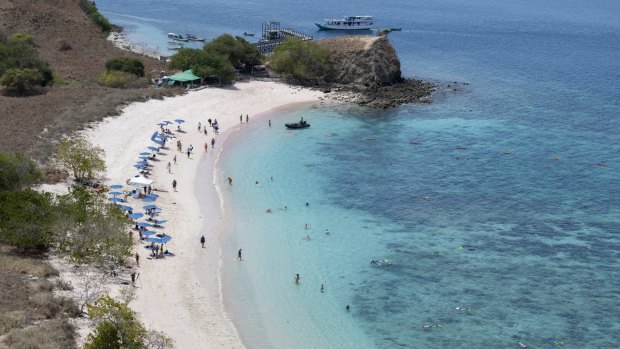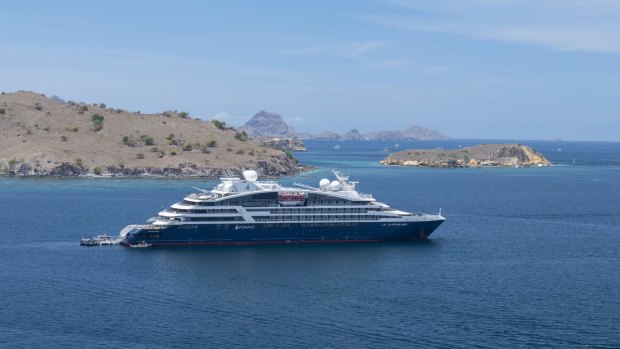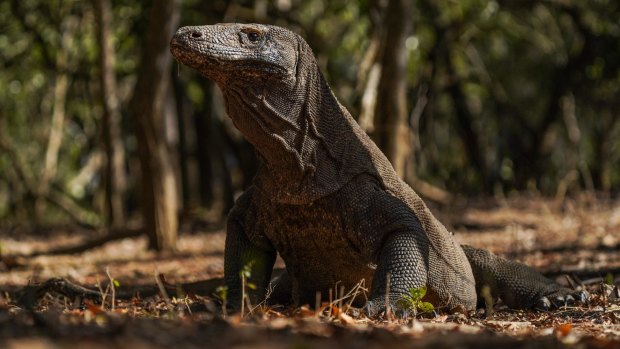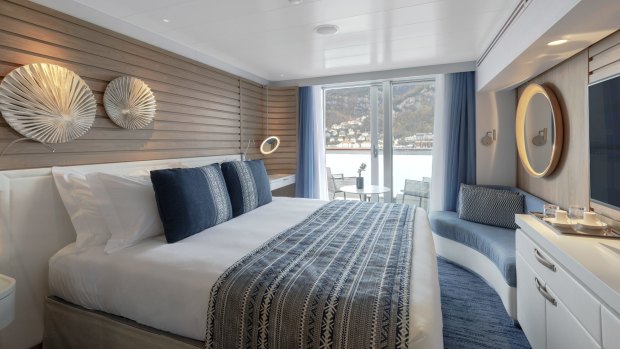This was published 1 year ago
Expedition cruise from the Kimberley to Komodo Island: Crocodiles and dragons
By Helen Pitt

On Komodo Island the dangers lurk on the land, not the water.
Suddenly, from my stateroom balcony aboard Ponant's vessel Le Laperouse, I see something large loom into view on the beach as we dock at Komodo Island.
I don't want to assume it's a Komodo dragon, the world's largest species of lizard, which I'm excited to see for the first time in the wild.
There are only 3700 Komodo dragons still roaming Indonesia's five Lesser Sunda Islands, the bulk of them, at last count 1700, on Komodo Island. Will we score the jackpot and see one?

Ponant Le Laperouse.
I've learnt, so far on this expedition adventure, it is good not to have expectations; better to be pleasantly surprised.
A few days before, while cruising through the Kimberley on our 14-day/15-night sea voyage from Broome to Bali, we visit El Questro station on a daytrip at Wyndham, with hopes to see Gouldian finches, Australia's most spectacularly coloured grassfinches. One passenger, a Sydney backyard aviary enthusiast, booked this cruise especially to see them; but alas we are unlucky. But on our hot hike up the rocky Emma Gorge we are rewarded with a dip in the glorious turquoise waterhole with waterfall teaming down the red rockface. By afternoon cruising the Chamberlain Gorge feeding the cheeky spitting archerfish, we laugh so much all thoughts of birds have flown from our minds.
It's the same at King George River, a remote part of the Kimberley, where we leave ship to hurtle down the river at breakneck speed in inflatable Zodiacs, hoping to see Western Australia's highest twin waterfalls Oomari (King George Falls) in full flight. When we arrive, there's not even a trickle. But there is another Zodiac at the base of the cliff near where the falls should be teaming, complete with cruise crew handing out flutes of amber coloured bubbles. When life gives you no water, Ponant gives you French champagne.

Komodos will eat anything with a heartbeat.
This could be the motto for the ultra-modern yacht cum cruise ship, named after naval officer Jean-François de Galaup, comte de Laperouse. It is part-pleasure cruise, part-expedition - and involves none of the hardships faced by the 18th-century French explorer for whom our vessel is named. He disappeared in 1785 without a trace while exploring the Pacific.
Whatever a day exploring on a 21st-century French vessel entails, there is always the comfort of your opulent stateroom to return to, one of 92 catering for a maximum of 184 guests; intimate indeed. And of course the fabulous French food and wine, spa, deck yoga and massages to console you if nature has not. Although with awe-inspiring locations all over the Kimberley, East Timor and the Indonesian archipelago, the natural wonders are so jaw-droppingly gorgeous you are unlikely to need much consolation.
Which gets me back to Komodo. What will this UNESCO World Heritage Site deliver?

At stateroom on board Le Laperouse.
Will it be like our expedition on Western Australia's Hunter River? The night before we venture out, our expedition leader, Josh Coates, who had worked for Broome crocodile hunter Malcolm Douglas, tells us all there is to know about these apex predators, but tries to hose down our expectations of croc spotting - just in case we see none. Our fellow Zodiac passenger, Jenny from Sydney's northern beaches, makes a wager with my son. If we see a crocodile, he needs to buy me one of the pretty silk scarves from the ship's gift shop.
Thanks to the eagle eye and binoculars of our expedition leader Madeline Newbury, who studied conservation management at the University of Wollongong, we have a hard-to-top eight crocodile day (and two turtles and a hammerhead shark). As we make our way back aboard the ship, the sun setting at the same time as the moon rises, Jenny jokes we can add one ochre-coloured scarf to our tally for that day. A night swim in the ship's pool under a full moon tops it off.
But will we be so lucky at Komodo?
Arriving at Komodo's Pink Beach, our journey hit a purple patch - of coral. The purple hues - from brain to cabbage coral - make snorkelling here a technicolour delight of tropical wonders as we spotted trigger, angel, butterfly, lion and frog fish, plus anemones packed with clown fish.
After eight days being unable to swim in the sea off the Kimberley because of crocs, putting down anchor at Pink Beach for some underwater sports is a welcome change.
I snorkel here with Ponant's French-Australian Expedition operations manager Sandrine Erwin-Rose, who dives down to pick up a sea cucumber to show it to me up close.
With more than 1000 species of fish and 260 types of coral in Komodo National Park - there is so much to see in the sea. It is a feast as fabulous as the French ones we enjoy onboard both day and night, either at the formal Nautilus restaurant or the more casual pool deck grill and smorgasbord.
At the end of our first day in Komodo, we climb to the top of the hill for a bird's-eye view of Pink Beach, which gets its colour from foraminifera, microscopic red organisms that live in the coral reefs and get washed ashore. We watch daytrippers on old wooden boats glide past, and chat to hawkers selling batik and pearls at one end of the beach. Our captain, Ludovic Provost, a keen sailor and triathlete when he is not captaining ships, even runs to the top of a nearby mountain and to our amazement paraglides back down.
These volcanic mountains keep us safe from the land-dwelling dragons on the other side of the island.
Dining after our day at Pink Beach with Erwin-Rose, who holds a Bachelor of Science in Tropical Zoology and Ecology, we reflect on the perfect day of pink hues we've just had over a glass of French rose washed down by a glorious crimson sunset.
With a special interest in herpetology, she confesses she is "beyond excited" to see the giant monitor lizards - the Varaunus komodoenis.
"I love the dragons," she tells me. "Seeing a Komodo dragon for the first time is a bit like seeing a crocodile for the first time. These apex predators remind us where we are on the food chain, sometimes we humans forget."
So when we pull into port on the lizard-dwelling side of the island, I'm beyond excited.
Especially, when I walk down the new wharf to discover the blob on the beach I saw from my balcony, was indeed my first Komodo dragon.
He's three metres or so in length, lumbering along the sand like he's straight from the set of Jurassic Park. His pokes out his tongue as he manoeuvers his giant body with each slow step. I'm pretty sure he's a male, as we've learnt there are far fewer females than males, the ratio being one to three. The females have a much shorter lifespan.
The island was closed for a year during the pandemic, to embark on a conservation project to increase the dragon population and preserve their habitat. When we get onto the beach our local guides - national park employees - are there to meet us, armed with giant sticks to ward off the these meat-eaters with razor sharp teeth and a venomous saliva that contains bacteria.
I'm slightly terrified as we trail them. Komodo dragons are unpredictable, we are told, very sensitive to smell, and can apparently smell meat, up to four kilometres away. Which makes me wonder if they can smell our food being prepared on the ship.
Basically Komodos will eat anything with a heartbeat, including humans, the guides tell us. They are one of the few vertebrates that can have "virgin births", made possible by parthenogenesis - in which an egg can develop into an embryo without being fertilized by a sperm.
They are cannibals too. The mother only protects eggs in her nest, not the babies, and will eat them if necessary. So to protect themselves from both their parents and other predators, the hatchlings climb into trees and live there for two to three years before roaming land.
I'm comforted to learn they can only run straight - they can't zig zag. So as we traverse the island looking for these large monitor lizards, I have my zig-zag escape plan plotted in my head.
Despite the horror stories and my fear factor, it is exhilarating to see these prehistoric looking creatures up close. We return to the ship sated; a seven-dragon day.
THE DETAILS
CRUISE
Solar Eclipse 2023: Indonesia to Australia's Kimberley - with Smithsonian Journeys
Benoa, Bali - Broome (9/4/23 - 24/4/23) From $26,830
Tropical Indonesian Odyssey
Darwin - Benoa, Bali (11/10/23 - 22/10/23) From $11,520 See au.ponant.com
FLY
Qantas and Virgin fly daily to Bali and Darwin from Sydney and Melbourne. See qantas.com virgin.com
MORE
Helen Pitt travelled as a guest of Ponant.
Sign up for the Traveller Deals newsletter
Get exclusive travel deals delivered straight to your inbox. Sign up now.